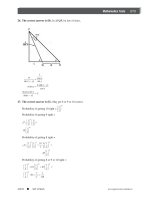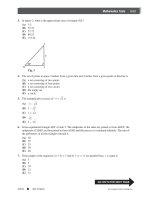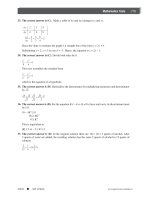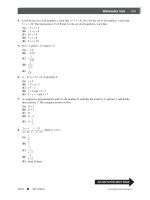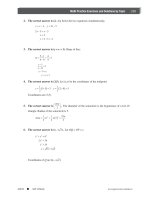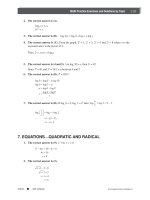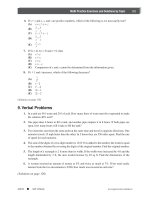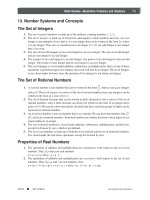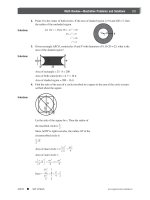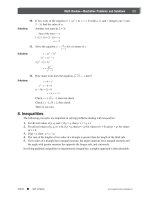SAT II History Episode 1 Part 1 pot
Bạn đang xem bản rút gọn của tài liệu. Xem và tải ngay bản đầy đủ của tài liệu tại đây (243.02 KB, 20 trang )
About Thomson Peterson’s
Thomson Peterson’s (www.petersons.com) is a leading provider of education information and advice, with books and
online resources focusing on education search, test preparation, and financial aid. Its Web site offers searchable
databases and interactive tools for contacting educational institutions, online practice tests and instruction, and planning
tools for securing financial aid. Thomson Peterson’s serves 110 million education consumers annually.
Petersons.com/publishing
Check out our Web site at www.petersons.com/publishing to see if there is any new information regarding the test and
any revisions or corrections to the content of this book. We’ve made sure the information in this book is accurate and
up-to-date; however, the test format or content may have changed since the time of publication.
For more information, contact Peterson’s, 2000 Lenox Drive, Lawrenceville, NJ 08648; 800-338-3282; or
find us on the World Wide Web at www.petersons.com/about.
Special thanks to Heidi Sheehan and W. Frances Holder for their editorial assistance.
For more information, contact Peterson’s, 2000 Lenox Drive, Lawrenceville, NJ 08648; 800-338-3282; or
find us on the World Wide Web at: www.petersons.com/about
COPYRIGHT © 2002 Peterson’s, a division of Thomson Learning, Inc.
Thomson Learning™ is a trademark used herein under license.
Previous editions © 2000, 2001
ALL RIGHTS RESERVED. No part of this work covered by the copyright herein may be reproduced or
used in any form or by any means—graphic, electronic, or mechanical, including photocopying,
recording, taping, Web distribution, or information storage and retrieval systems—without the prior
written permission of the publisher.
For permission to use material from this text or product, submit a request online at www.thomsonrights.
com
Any additional questions about permissions can be submitted by e-mail to
ISBN 0-7689-0908-2
Printed in the United States of America
10987654321 040302
Third Edition
CONTENTS
QUICK REFERENCE GUIDE V
RED ALERT 1
Top 10 Strategies for Acing the Test 1
10 Facts About the SAT II: U.S. History Test
Scoring High on the SAT II: U.S. History Test 5
Practice Plan for Studying for the SAT II: U.S. History
Test 8
Panic Plan 11
Why Take the Diagnostic Test? 12
DIAGNOSTIC TEST 13
Answers and Explanations 32
CHAPTER 1: STRATEGIES FOR MULTIPLE-CHOICE QUESTIONS 49
CHAPTER 2: R
EVIEWING THE COLONIAL PERIOD TO 1789 70
CHAPTER 3: R
EVIEWING THE NEW NATION TO MID-CENTURY . . 104
CHAPTER 4: R
EVIEWING THE EVENTS LEADING TO THE CIVIL
WAR AND ITS AFTERMATH 134
CHAPTER 5: R
EVIEWING HOW THE NATION BECAME AN
URBAN AND INDUSTRIAL POWER 154
CHAPTER 6: R
EVIEWING THE NATION’S GOALS AND IDEALS 174
CHAPTER 7: R
EVIEWING THE GREAT DEPRESSION,WORLD
WAR II, AND THE POST-WAR NATION 191
iii
CHAPTER 8: REVIEWING THE KENNEDY TO THE BUSH
ADMINISTRATIONS 214
PRACTICE TEST 1 233
Answers and Explanations 252
PRACTICE TEST 2 267
Answers and Explanations 286
PRACTICE TEST 3 303
Answers and Explanations 324
ANSWER SHEETS 341
CONTENTS
iv
QUICK REFERENCE GUIDE
Analyzing Questions 53
Basic Information About the Test 49
Educated Guessing: A Helpful Technique 51
Quick Overview of the U.S. Constitution 99
Quick Guide to the Information Tables
Native Americans of the United States 71
Key Explorers and Their Achievements 73
The Thirteen English Colonies 76
Social Structure of the Thirteen English Colonies 82
Economic Development in the Thirteen English
Colonies 83
Mercantile Laws 87
Anglo-French Wars 87
British Legislative Actions Leading to the Revolution. 89
Articles of Confederation 96
Social System of the Antebellum South 122
Acquisitions/Present States 135
Labor Unrest 163
Progressives and Populists 178
Washington, Du Bois, Garvey 180
New Deal Legislation 194
Axis Aggression 200
World War II Conferences 204
Civil Rights Legislation 215
Civil Rights Movement 217
Scoring Overview 5
Some Landmark Supreme Court Decisions
Marbury v. Madison 111
McCulloch v. Maryland 115
Gibbons v. Ogden 119
Scott v. Sanford (Dred Scott) 140
Plessy v. Ferguson 156
Schenck v. United States 186
Brown v. Board of Education of Topeka 211
Heart of Atlanta v. United States 216
Wesbery v. Sanders 217
Gideon v. Wainwright 219
Miranda v. Arizona 219
Roe v. Wade 224
v
For additional review material, be sure to read the
“Answers and Explanations”
Diagnostic Test 32
Practice Test 1 254
Practice Test 2 288
Practice Test 3 326
FIVE IMPORTANT STRATEGIES
1. Highlight the key words in the question so you will know what you are
looking for in the answer choices.
2. With a not/except question, ask yourself if an answer choice is true about
the subject of the question. If it is true, cross it off and keep checking
answers.
3. If you aren’t sure about an answer but know something about the ques-
tion, eliminate what you know is wrong and make an educated guess.
4. To help in making an educated guess, check the time frames of the
question immediately above and immediately after the question you are
trying to answer. Cross off any answer choices that don’t fit within that
time frame.
5. All parts of an answer choice must be correct for the answer to be
correct.
QUICK REFERENCE GUIDE
vi
TOP 10 STRATEGIES FOR ACING THE TEST
PREPARING FOR
THE
TEST:
1. Read the 10 Facts About the SAT II: U.S. History Test on pages
2–5 in this book.
2. Choose your Practice Plan from pages 8–10 in this book.
3. Choose a place and time to study every day, and stick to your
routine and your plan.
4. Even though they are time-consuming, complete the Diagnostic
and Practice Tests in this book. They will give you just what they
promise: practice—practice in reading and following the direc-
tions, practice in pacing yourself, and practice in understanding
and answering multiple-choice questions.
5. Complete all your assignments for your regular U.S. history
course. Ask questions in class and talk about what you are
reading and learning. The test is supposed to measure what you
know and understand about U.S. history and related social
science concepts, methods, and generalizations.
THE NIGHT BEFORE
THE
TEST:
6. Assemble what you will need for the test: your admission
materials, four number 2 pencils, a watch (without an alarm),
and a healthy snack for the break if you are taking several tests
on one day. Put these items in a place where you will not forget
them in the morning.
7. Don’t cram. Relax. Go to a movie, visit a friend—but not one
who is taking the test with you. Get a good night’s sleep.
THE DAY OF
THE
TEST:
8. Wear comfortable clothes. If you have a lucky color or a lucky
piece of clothing or jewelry, wear it—as long as you won’t
distract anyone else. Take along a lucky charm if you have one.
9. If you do not usually eat a big breakfast, this is not the morning
to change your routine, but it is probably a good idea to eat
something nutritious if you can.
10. If you feel yourself getting anxious, concentrate on taking a
couple of deep breaths. Remember, you don’t have to answer all
the questions, and you can make EDUCATED GUESSES.
RED ALERT
RED ALERT
1
Peterson’s n SAT II
Success: U.S. History www.petersons.com
10 FACTS ABOUT THE SAT II: U.S. HISTORY TEST
1. UNLIKE THE SATITEST,WHICH ASSESSES CRITICAL READING AND THINKING,
THE SATIISUBJECT TESTS ASSESS SPECIFIC KNOWLEDGE.
The twenty-two Scholastic Assessment Tests, formerly known as the
College Board Achievement Tests, assess student knowledge in
specific subject areas. The tests are 1 hour each and, except for the
Writing Test, use a multiple-choice format to test knowledge of
subjects such as biology, mathematics, world history, and modern
Hebrew. Some of the world language tests have a listening compo-
nent. The SAT II: Writing Test has both a 20-minute essay section as
well as a 40-minute multiple-choice section.
2. THE SAT II: U.S. HISTORY TEST MEASURES FACTUAL KNOWLEDGE,
A
NALYTICAL SKILLS, AND THE ABILITY TO EVALUATE DATA.
Study Strategy
Learn strategies for answer-
ing the different types of test
questions in Chapter 1.
The College Board descriptive information about the SAT II: U.S.
History Test states that it assesses a student’s knowledge of the
nation’s political, economic, social, intellectual, and cultural history as
well as foreign policy. The literature identifies four purposes for the
questions:
• to test recall of basic information, such as facts, terms,
concepts, and generalizations,
• to analyze and interpret visuals, such as cartoons, maps,
charts, graphs, and photographs,
• to relate ideas to given data,
• to evaluate data.
3. THE SAT II: U.S. HISTORY TEST COVERS U.S. HISTORY FROM THE FIRST
AMERICANS TO CURRENT EVENTS.
Study Strategy
See Chapters 2 through 8 for
a brief review of U.S. history.
Although you will find questions from all time periods of U.S. history,
most of them will be taken from the nineteenth and twentieth
centuries. The College Board states that about approximately
• 20 percent of the questions are based on history from
pre-Columbian times through 1789,
• 40 percent are from 1790 to 1898,
• 40 percent are from 1899 to the present.
The College Board further breaks down the kinds of information
that it tests. Because history is a complex entity that mixes many
strands, the College Board states that the questions are divided
according to the following categories:
RED ALERT
RED ALERT
2
Peterson’s n SAT II
Success: U.S. Historywww.petersons.com
• 32–36 percent on political history,
• 18–22 percent on social history,
• 18–20 percent on economic history,
• 13–17 percent on foreign policy,
• 10–12 percent on cultural and intellectual history.
Within these historical periods and categories, the test writers will
also ask you about social science concepts, methods, and generaliza-
tions.
4. THE SAT II: U.S. HISTORY TEST ASKS ONLY MULTIPLE-CHOICE QUESTIONS.
Study Strategy
See Chapter 1 for strategies
for answering multiple-
choice questions.
The SAT II: U.S. History Test does not contain an essay question. The
test is made up of ninety to ninety-five multiple-choice questions
arranged in chronologically ordered clusters. That means that you
may find a group of seven to twelve questions that progresses from a
question on pre-Columbian history through questions on the various
eras to the end of the twentieth century. The questions also become
more difficult as you progress through the test.
The test uses a variety of types and prompts for its questions.
You may find EXCEPT, LEAST, or NOT (reverse true/false) questions,
questions based on visuals, and questions based on quotations from
documents and people’s writings. Most questions simply present a
statement for you to complete by choosing one of five possible
responses.
5. PACING YOURSELF IS IMPORTANT IN ANSWERING THE SAT II:
U.S. H
ISTORY TEST.
Study Strategy
See Chapter 1 for more
information on pacing.
You will have 60 minutes to answer ninety to ninety-five questions.
That works out to reading and answering one question every 45
seconds. You may not be able to answer all ninety questions, but you
will not be penalized for questions that are left unanswered.
6. EDUCATED GUESSING CAN HELP.
Study Strategy
See Scoring High for more
information on how scores
are computed.
While your score will not be affected by unanswered questions,
questions that are answered incorrectly will result in a quarter-point
deduction for each. In computing your score, the College Board
awards a point for each correct answer and deducts a quarter-point
for each incorrect answer. The College Board suggests guessing IF
you know something about a question and can eliminate a couple of
answer choices. Call it “educated guessing.”
RED ALERT
RED ALERT
3
Peterson’s n SAT II
Success: U.S. History www.petersons.com
7. WHETHER AND WHEN YOU SHOULD TAKE THE SAT II: U.S. HISTORY TEST
DEPENDS ON THE COLLEGES YOU ARE APPLYING TO.
Not all colleges require SAT II subject tests, so check the catalogues
and Web sites of the colleges that you are applying to in order to see
which tests, if any, they require. Some colleges may require the SAT
II tests for admission, while others may use the tests for placement.
The U.S. History Test is administered six times a year in Octo-
ber, November, December, January, May, and June. To use the test
for regular admission, you will need to have taken it by November or
January of your senior year. For early admission, you will need to take
it earlier. If the college you are going to attend uses the test for
placement only, you may be able to wait until May or June.
However, the College Board advises students to take its SAT II
tests while the course work is still fresh. Since U.S. history is often a
two-year sequence in 10th and 11th grades or a one-year course in
11th grade, it would make the most sense to take the test at the end
of junior year.
Even if the schools you are applying to do not require the test, it
may be helpful for you to add the score to your other documents.
Because courses may vary widely from school to school, the SAT II
subject tests provide a degree of comparability among student grades.
8. YOU CAN TAKE THE SAT II: U.S. HISTORY TEST MORE THAN ONCE.
There is no limit to the number of times you can take an SAT II test.
All scores will be reported to the colleges of your choice. You
shouldn’t worry if your first score isn’t as high as you would like.
Admissions officers take into consideration a range of scores.
9. ALL THE INFORMATION ABOUT REGISTRATION AND FEES IS AVAILABLE FROM THE
COLLEGE BOARD.
To take the SAT I or any SAT II test, you will need to register with
the College Board. See your guidance counselor for a copy of the SAT
Registration Bulletin or write or call:
College Board SAT II Program
PO Box 6200
Princeton, NJ 08541-6200
609-771-7600
RED ALERT
RED ALERT
4
Peterson’s n SAT II
Success: U.S. Historywww.petersons.com
Also ask for a copy of Taking the SAT II: Subject Tests. The Bulletin
lists test sites and dates and has information about the process for
having your scores reported to colleges. In certain cases, financial
help is available for the registration fee. Accommodations can also be
made for students with disabilities. Ask your guidance counselor or
the College Board if you think that you qualify.
You may take as many as three SAT II subject tests on any one
day, but if you are taking the SAT II Writing Test or a Language Test
with Listening, either will be the first test that you take on that day.
10. STUDYING FOR THE TEST CAN MAKE A DIFFERENCE.
The first step in studying for the U.S. History Test is to learn the
format of the questions and the directions. Then you will not waste
time on the day of the test trying to understand what you are
supposed to do.
The second step is to review the content of U.S. history. Stop
first at page 8 and read the Practice Plan for Studying for the SAT II:
U.S. History Test.
SCORING HIGH ON THE SAT II: U.S. HISTORY TEST
You have taken hundreds of tests during your time in school. Most of
these tests have evaluated your knowledge of a subject or your
mastery of a skill. The SAT II: U.S. History Test is no different. The
test makers write questions to see how well you remember and
understand U.S. history and social science concepts and generaliza-
tions. While this examination may seem especially challenging, like
other standardized tests, if you have studied and you know some
test-taking techniques, you can do well.
USING TIPS IN THIS BOOK TO IMPROVE YOUR SCORE
Study Strategy
Check the Practice Plan on
pages 8–10 for help in
setting up a study schedule.
Throughout this book you will find information that describes and
explains the SAT II: U.S. History Test. In this Red Alert! section, you
will find some basic information as well as tips to help you ace the
test. Use this section and the chapters that follow as a study guide to
complement your regular U.S. history course work.
RED ALERT
RED ALERT
5
Peterson’s n SAT II
Success: U.S. History www.petersons.com
Study the strategies and techniques presented in Chapter 1,
Strategies for Multiple-Choice Questions, and complete the practice
sets of questions. By doing these exercises and taking the Diagnostic
Test and Practice Tests, you will improve your test-taking skills.
Correct your responses against the answer keys and the Answers and
Explanations, and you will be able to pinpoint those periods in U.S.
history that you need to spend more time reviewing. By reading all
the answer explanations, you will also be reinforcing and extending
those areas that you already know well.
As you practice taking the tests and checking your responses,
always consider what your weak areas are and what you can do to
improve. Make a list of the time periods that you need to review, and
check them off as you become confident about each one. Strive to
answer more multiple-choice questions correctly in the 60 minutes.
Work to apply the test-taking strategies suggested in Chapter 1. If you
take time to do all the practice tests, you will increase your test-
taking skills and your score on the real test day.
SCORING THE TEST
Test-Taking Strategy
To make the most of the test,
you will need to pace
yourself. See Chapter 1 for
some strategies for pacing.
The SAT II: U.S. History Test is scored on a scale of 200 to 800. You
are thinking that you have to answer all ninety or ninety-five ques-
tions correctly to attain a score of 800. Well, you don’t. Based on a
recent release of the scaled scoring chart from the College Board,
students who answered some combination of correct and incorrect
answers and left blank some number of questions that resulted in raw
scores of 90 to 81 received “perfect” scores of 800. Your response to
that fact may be “What?”
And students who answered some combination of correct and
incorrect answers and left blank some number of questions that
resulted in raw scores of −21 and −22 achieved scores of 230.
“WHAT?”
The College Board has devised a scoring system that converts
raw scores to scaled scores. According to the College Board, the
purpose is “to ensure that a score earned on any one edition of a
particular Subject Test is comparable to the same scaled score on any
other edition of the same test.” This is one element of the compara-
bility that helps colleges in evaluating students’ Subject Test scores.
The scaled scores assign a value to each raw score. For example, for
a recent SAT II: U.S. History Test, the middle range of scores looked
like this:
50 620
49–48 610
47–46 600
45 590
44–43 580
RED ALERT
RED ALERT
6
Peterson’s n SAT II
Success: U.S. Historywww.petersons.com
You receive 1 point for every correct answer, a quarter-point
deduction for every incorrect answer, and no penalty for questions
left blank. In figuring out your own score, give yourself 1 point for
each correct answer, and multiply the total number of incorrect
answers by 0.25. The scale may change from year to year, but you
can figure out generally what your converted score will be by
establishing 81 to 90 as 800 (or 83 to 95) and then deducting 10
points for every 2 points that your raw score decreases, for example:
80–79 790
78–77 780
76–75 770
74–73 760
72–71 750
What does this mean to you? Well, for one thing, knowing that
you can answer some combination of questions correctly and
incorrectly and leave some blank and still get a score in the 500s and
600s should take some of the anxiety out of your test-taking.
EDUCATED GUESSING:AHELPFUL TECHNIQUE
You may be concerned about guessing when you are not sure of the
answer or when time is running out. We have more to say about
pacing in Chapter 1, but even the College Board recommends
guessing IF you know something about the question and can elimi-
nate one or more of the answer choices. Call it “educated guessing.”
Here are some suggestions for making an educated guess:
• Ignore answers that are obviously wrong.
• Discard choices in which part of the response is incorrect.
Remember that a partially correct answer is a partially
incorrect answer—and a quarter-point deduction.
• Reread the remaining answers to see which seems more
correct.
• Choose the answer that you feel is right. Trust yourself. Your
subconscious usually will guide you to the correct choice. Do
not argue with yourself. This works IF you know something
about the question content to begin with.
You may still be concerned about the quarter-point deduction,
known as the “guessing penalty,” but we are not talking about
guessing but about making an “educated guess.” If you use our
suggestions, your chances of increasing your score are very good.
You will have to answer four questions incorrectly to loose a single
point, yet one correct educated guess will increase your score by 1
point. IF you know something about the question and can eliminate
one or more answer choices, why not act on what you know and fill
in the oval for your best answer choice?
RED ALERT
RED ALERT
7
Peterson’s n SAT II
Success: U.S. History www.petersons.com
SOME REMINDERS ABOUT THE SAT: II U.S. HISTORY TEST
Study Strategy
See Chapter 1 for strategies.
Here are three important ideas to remember about taking the test:
1. It is important to spend time practicing the kinds of questions
that you will find on the test.
Study Strategy
See Chapter 1 for more on
pacing.
2. You can leave some questions unanswered and still do well. Even
though you will be practicing how to pace yourself as you use
this book, you may not be able to complete all ninety or ninety-
five questions on the day of the test. If you come across a really
difficult question, you can skip it and still feel that you are not
doomed to receive a low score.
3. There is a guessing penalty. If you do not know anything about a
question or the choices, do not take a chance. However, if you
know something about the question and can eliminate one or
more of the answer choices, then it is probably worth your while
to choose one of the other answers. Use EDUCATED GUESSING.
Even the College Board advises this strategy.
PRACTICE PLAN FOR STUDYING FOR THE SAT II:
U.S. HISTORY TEST
The following plan is worked out for nine weeks. The best study plan
is one that continues through a full semester. Then you have time to
think about ideas and to talk with your teacher and other students
about what you are learning, and you will not feel rushed. Staying
relaxed about the test is important. A full-semester study plan also
means that you can apply what you are learning here to class work
and apply your class work—everything that you are reading—to test
preparation. The plan is worked out so that you should spend
between 2 and 3 hours on each lesson.
Week 1
First: Take the Diagnostic Test, pp. 13–31, and complete the
self-scoring process.
List the areas that you had difficulty with: pacing, question
types, or content.
Then: Reread pp. 2–7 about the basic facts of the test and its
scoring.
RED ALERT
RED ALERT
8
Peterson’s n SAT II
Success: U.S. Historywww.petersons.com
Week 2
Lesson 1 • Read Top 10 Strategies for Acing the Test, p. 1.
• Reread Scoring High on the SAT II: U.S. History Test, pp. 5–7.
• Read Chapter 1, Strategies for Multiple-Choice Questions, pp.
49–69.
• Do one set of practice questions at the end of the chapter, and
review the explanation of the answers.
Lesson 2 • Review the list you made after the Diagnostic Test to see what you
need to learn/review about early U.S. history in order to do well.
• Read Chapter 2, Reviewing the Colonial Period to 1789, and find
out more about any of the people, terms, and concepts that are
unfamiliar to you.
Week 3
Lesson 1 • Reread Top 10 Strategies for Acing the Test, p. 1.
• Reread Scoring High on the SAT II: U.S. History Test, pp. 5–7.
• Review Chapter 1, Strategies for Multiple-Choice Questions, pp.
49–69.
• Do one set of practice questions at the end of the chapter, and
review the answers.
Lesson 2 • Review the list you made after the Diagnostic Test to see what you
need to learn/review about the new nation.
• Read Chapter 3, Reviewing the New Nation to Mid-Century, and
find out more about any of the people, terms, and concepts that
are unfamiliar to you.
Week 4
Lesson 1 • Review Chapter 1, Strategies for Multiple-Choice Questions, pp.
49–69, and do another set of practice questions at the end of the
chapter.
• Review the answers for these practice questions.
• Review the content from Chapters 2 and 3 that showed up as gaps
in your knowledge when you took the Diagnostic Test.
Lesson 2 • Take Practice Test 1 and complete the self-scoring process.
• Compare the score to your score on the Diagnostic Test. Which
question types continue to be a concern?
• Reread Chapter 1, Strategies for Multiple-Choice Questions, as
needed.
RED ALERT
RED ALERT
9
Peterson’s n SAT II
Success: U.S. History www.petersons.com
Week 5
Lesson 1 • Read Chapter 4, Reviewing the Events Leading to the Civil War
and Its Aftermath, and find out more about any people, terms, or
concepts that are unfamiliar to you.
Lesson 2 • Read Chapter 5, Reviewing Becoming an Urban and Industrial
World Power, and find out more about any people, terms, or
concepts that are unfamiliar to you.
Week 6
Lesson 1 • Review the content in Chapters 2 through 5 that showed up as
gaps in your knowledge when you took the Diagnostic Test and
Practice Test 1.
• If you still feel unsure of some question types, review Chapter 1.
Lesson 2 • Take Practice Test 2 and complete the self-scoring process.
• Compare the score to your score on the Diagnostic Test. Which
question types and historical eras continue to be a concern?
Week 7
Lesson 1 • Read Chapter 6, Reviewing the Nation’s Goals and Ideals, 1898–
1929, and find out more about any people, terms, or concepts that
are unfamiliar to you.
Lesson 2 • Read Chapter 7 Reviewing the Great Depression, World War II,
and the Post-War Nation, and find out more about any people,
terms, or concepts that are unfamiliar to you.
Week 8
Lesson 1 • Read Chapter 8, Reviewing the Kennedy Through Bush Adminis-
trations, and find out more about any people, terms, or concepts
that are unfamiliar to you.
Lesson 2 • Review the content in Chapters 2 through 8 that showed up as
gaps in your knowledge when you took the Diagnostic Test and
Practice Tests 1 and 2.
Week 9
Lesson 1 • Take Practice Test 3 and complete the self-scoring process. Check
your results against the other two tests.
Lesson 2 • If you are still unsure about some content and test-taking strategies,
review those chapters and the practice activities.
• Reread Scoring High on the SAT II: U.S. History Test, pp. 5–7, and
Top 10 Strategies for Acing the Test, p.1.
RED ALERT
RED ALERT
10
Peterson’s n SAT II
Success: U.S. Historywww.petersons.com
THE PANIC PLAN
Eighteen weeks, nine weeks, how about two weeks? If you are the
kind of person who puts everything off until the last possible minute,
here is a two-week panic plan. Its objectives are to make you familiar
with the test format and directions and to help you get as many right
answers as possible.
Week 1
• Read Top 10 Strategies for Acing the Test, p. 1, and Scoring High
on the SAT II: U.S. History Test, pp. 5–7.
• Take the Diagnostic Test. Read the directions carefully and use a
timer.
• Complete the self-scoring process. You can learn a lot about the
types of questions in the multiple-choice section by working
through the answers.
• Read Chapter 1, Strategies for Multiple-Choice Questions, paying
particular attention to the types of questions that you had difficulty
with on the Diagnostic Test.
• Read Chapter 2, Reviewing the Colonial Period to 1789, pp.
70–103.
• Read Chapter 3, Reviewing the New Nation to Mid-Century, pp.
104–133.
• Take Practice Test 1.
• Complete the self-scoring process, and see where you may still
have problems with question types. Reread those sections of
Chapter 1 and complete at least one set of practice questions.
• Read all the answer explanations including those you identified
correctly.
Week 2
• Reread Top 10 Strategies for Acing the Test, p. 1, and Scoring High
on the SAT II: U.S. History Test, pp. 5–7.
• Complete Practice Test 2 and score it. Read all the answer explana-
tions including those you identified correctly. Where are you still
having problems with content? With question types?
• Read Chapters 4 through 8.
• Reread Chapter 1, Strategies for Multiple-Choice Questions, as
needed.
• Take Practice Test 3 and score it. Read all the answer explanations
including those you identified correctly. Still having content
problems? Review those areas in Chapters 2 through 8.
• Work at least two practice sets of multiple-choice questions in
Chapter 1.
RED ALERT
RED ALERT
11
Peterson’s n SAT II
Success: U.S. History www.petersons.com
WHY TAKE THE DIAGNOSTIC TEST?
What do you know about the format and questions on the SAT II:
U.S. History Test? If you knew all you needed to know, you probably
would not be reading this book. Taking a practice test is one way to
learn about the test and what it will be like taking it on the real test
day. You will need to pace yourself so you can answer as many
questions as possible in the 60 minutes. Taking the Diagnostic Test
will help you learn how much time you can spend on each item.
Practice may not make perfect, but you can improve your score
with practice. The more you learn about your strengths and weak-
nesses in test-taking abilities and in analytical skills and the more you
work on strengthening them, the better your score.
How should you take this test? Just as though it were the real
test, so that means setting aside 1 hour of uninterrupted quiet time to
take the test, plus the time to score your answers.
• Make a photocopy of an answer sheet at the back of this book.
• Assemble four number 2 pencils along with the answer sheet.
• Get a timer or a stopwatch to time the test.
• When you have completed the test, check how many questions
you were able to answer. This information will help you in pacing
yourself for the Practice Tests and for the real test.
• Then check the multiple-choice questions against Quick-Score
Answers, p. 32.
• Read the explanation for each answer, even if your answer was
correct. You might learn something you didn’t know about that
period in U.S. history.
• By reading the answers, you may also be able to pick up a pattern
about which eras in American history you need to spend more time
reviewing. Knowing your weak areas is the only way to strengthen
them.
• Turn to the Practice Plan and design your study plan from now
until test day.
RED ALERT
RED ALERT
12
Peterson’s n SAT II
Success: U.S. Historywww.petersons.com
DIAGNOSTIC TEST
While you have taken many standardized tests and know to blacken completely the ovals on the
answer sheets and to erase completely any errors, you need to indicate on the answer key which test
you are taking. The instructions on the answer sheet will tell you to fill out the top portion of the
answer sheet exactly as shown.
1. Print U.S. History on the line to the right under the words Subject Test (print).
2. In the shaded box labeled Test Code fill in four ovals:
—Fill in oval 2 in the row labeled V.
—Fill in oval 5 in the row labeled W.
—Fill in oval 5 in the row labeled X.
—Fill in oval C in the row labeled Y.
—Leave the ovals in row Q blank.
Test Code
V
ÞO
1
Þ ÞO
3
ÞO
4
ÞO
5
ÞO
6
ÞO
7
ÞO
8
ÞO
9
W ÞO
1
ÞO
2
ÞO
3
ÞO
4
Þ ÞO
6
ÞO
7
ÞO
8
ÞO
9
X ÞO
1
ÞO
2
ÞO
3
ÞO
4
Þ Y ÞO
A
ÞO
B
Þ ÞO
D
ÞO
E
Q ÞO
1
ÞO
2
ÞO
3
ÞO
4
ÞO
5
ÞO
6
ÞO
7
ÞO
8
ÞO
9
Subject Test (print)
U.S. HISTORY
There are two additional questions that you will be asked to answer: How many semesters of
U.S. history have you taken? Have you taken courses in government, economics, geography, psychol-
ogy, sociology, and/or anthropology? The College Board is collecting statistical information. If you
choose to answer, you will use the key that is provided and blacken the appropriate ovals in row Q.
You may also choose not to answer, and that will not affect your grade.
When everyone has completed filling in this portion of the answer sheet, the supervisor will tell you
to turn the page and begin. The answer sheet has 100 numbered ovals on the sheet, but there are
only 90 (or 95) multiple-choice questions on the test, so be sure to use only ovals 1 to 90 (or 95) to
record your answers.
➡
GO ON TO THE NEXT PAGE
13
Peterson’s n SAT II
Success: U.S. History www.petersons.com
Directions: Each of the questions or incomplete statements below has five suggested answers or
completions. Choose the response that is best and then fill in the corresponding oval on the
answer sheet.
1. By the time the Europeans arrived, the Native
Americans of the Northeast Woodlands lived
primarily by
(A) fishing
(B) farming
(C) hunting and gathering
(D) trade
(E) raiding
2. Great Britain’s policy of governing its
colonies to build up its own gold reserves
and expand trade is known as
(A) nationalism
(B) favorable balance of trade
(C) mercantilism
(D) Navigation Acts
(E) enumerated goods
3. “On almost all questions, great and small,
which have come up since the first session
of Congress, ________ and ________ have
been found among those who want to limit
federal power. In respect to foreign policy,
the views of these gentlemen are, in my
judgement, equally unsound and dangerous.
They have a womanish attachment to France
and a womanish resentment against Great
Britain.”
The above statement was probably
written by
(A) Thomas Jefferson
(B) James Madison
(C) Alexander Hamilton
(D) Alexis de Tocqueville
(E) Edmund Burke
4. The two men whose names are omitted in
the quotation above are most probably
I. Thomas Jefferson
II. James Madison
III. Alexander Hamilton
IV. Alexis de Tocqueville
V. George Washington
(A) I and II only
(B) II and III only
(C) I and III only
(D) III and IV only
(E) II and V only
5. The issue of protective tariffs led to fierce de-
bate in Andrew Jackson’s administration over
(A) internal improvements
(B) Indian removal
(C) states’ rights
(D) popular sovereignty
(E) specie circular
6. All of the following were true of U.S. foreign
policy during the second half of the nine-
teenth century EXCEPT
(A) the United States purchased Alaska from
Canada
(B) business interests influenced U.S.
annexation of Hawaii
(C) the Open Door policy in China brought
the United States little gain
(D) the Spanish American War resulted in
U.S. acquisition of an empire
(E) in an effort to improve relations with
Latin American nations, the United States
invited them to an Inter-American
conference in Washington in 1889
SAT II SUCCESS: U.S. HISTORY
DIAGNOSTIC TEST—Continued
14
Peterson’s n SAT II
Success: U.S. Historywww.petersons.com
